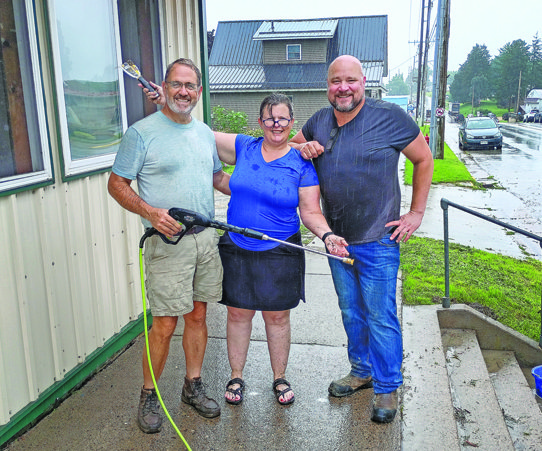LOWER WISCONSIN RIVER - At their board meeting in Spring Green on Thursday, Sept. 8, members of the Lower Wisconsin State Riverway Board (LWSRB) learned about how water levels are regulated on the Lower Wisconsin River. Kathryn Wilhelm and Amanda Blank of Alliant Energy made a presentation to the board and almost 30 citizens at the meeting.
Blank is the former manager of the Alliant Energy Dam at Prairie du Sac, and Wilhelm is the newly appointed manager. Blank managed the dam for nine years before moving on to manage dams in the Beloit area. Wilhelm has worked for Alliant Energy for the last 22 years.
“Alliant held a celebration of the 100th anniversary of the Prairie du Sac Dam in 2014 – construction began on the dam in 1911, and it went into operation in 1914,” Blank said. “Alliant has owned and operated the dam since 1970, and also owns and operates the Kilbourn Dam in the Wisconsin Dells.”
Blank explained that both dams operate under a license from the Federal Energy Regulatory Commission (FERC). She said that both dams have a ‘Run of the River’ license. Electricity generated from the Prairie du Sac Dam, from its eight turbines, is enough to power 30,000 homes.
“Our license strictly defines how water levels in the Lake Wisconsin impoundment above the dam must be maintained – we are limited to varying the level by one-tenth of a foot or about seven inches,” Blank explained. “River flow is measured in cubic-feet-per-second (cfs), and the average flow at the dam is 9,000 cfs, with the maximum when all eight turbines are running of 13,000 cfs.”
Blank explained that one way to visualize what a cubic-foot-per-second looks like is to think of the unit as about the size of a basketball. She said that this would mean that between 9,000 and 13,000 basketballs flow through the dam every second. This amounts to about four million-gallons-per-minute, or 5.8 billion gallons-per-day. The Lake Wisconsin impoundment behind the dam holds about 39 million gallons of water.
According to the ‘Energy Education’ website, a “run-of-the-river hydroelectric system harvests the energy from flowing water to generate electricity in the absence of a large dam and reservoir… The primary difference between this type of hydroelectric generation compared to others is that run-of-the-river primarily uses the natural flow rate of water to generate power—instead of the power of water falling a large distance. However, water may still experience some vertical drop in a run-of-the-river system from the natural landscape or small dam. Another main difference between traditional hydropower is that run-of-the-river hydro is used in areas where there is little to no water storage, such as in a river.”


The reservoirs are owned in common by all of the property owners on the river, and administered by Wisconsin Valley Improvement Company (WVIC). These reservoirs impound about one-sixth of all the water in the Wisconsin River system, and according to Blank, the rest of the water comes from runoff. She said that approximately 25 percent of Wisconsin’s landscape drains into the Wisconsin River basin.
According to the WVIC website, the reservoir system was initiated in 1907 and 1908 with the acquisition of 16 existing logging dams. These dams are all located at the outlets of natural lakes on streams that are tributary to the Wisconsin River, except for Lac Vieux Desert which is located at the outlet of a natural lake that is the origin of the Wisconsin River. The dams raised the levels of the associated natural lakes by several feet and were used in the late 1800s for transporting logs to downstream industrial facilities.
This was done by storing water in the lakes and then opening the dam to cause a large artificial rise in river flow, generally at the same time natural flooding was already occurring. The release of that added water would then float logs stored in the lakes to downstream markets.
When WVIC acquired these dams the operation pattern was changed so that the storage and release of water from the lakes could be used to achieve more uniform downstream river flow. This operation is exactly opposite of that used for logging purposes. These reservoirs are known as natural-lake reservoirs.
From 1911 to 1937 WVIC constructed five new reservoirs, known as man-made reservoirs, to increase the capacity of the system. The five man-made reservoirs (Rainbow, Willow, Rice, Spirit, and Eau Pleine) have a larger range of allowable water level limits and hence much greater usable storage capacities than the natural-lake reservoirs. The five man-made reservoirs account for 73 percent of the system's total usable reservoir storage.
The 16 natural-lake reservoirs account for the remaining 27 percent of the usable storage available in the system.
Blank explained that for each dam, there is an Emergency Action Plan (EAP) which takes into account the hydraulic shadow of the dam, and uses calculations of how fast and far the water in the impoundment behind the dam would travel in the event the dam was breached. She said that all the dams in the system also have integrated EAP’s allowing them to communicate and work together in the event of an incident anywhere in the system.
One meeting participant asked Blank if Alliant Energy changed water levels in Lake Wisconsin to meet peak demand for electricity.
Blank answered that because the two Alliant dams have a run-of-the-river license, they are tightly constrained in the extent of water level variation they are allowed to make. She said that other dams upriver in the system are not licensed in this way, and so Alliant will see the effects of those dams manipulating water levels in the stretches of the river controlled by Alliant’s two dams.
Highway 130 bridge
Brent Freeman of Kramer North America was on hand to update the board about the Highway 130 bridge replacement project. The bridge, which crosses the Wisconsin River near Lone Rock, will be replaced with construction scheduled to begin in 2023, and be completed in 2025.
Wisconsin Department of Transportation is using a new process for highway improvement projects called the ‘Design-Build Program.’ The program is in pilot phase right now, and the Highway 130 bridge replacement project was one of three that is part of DOT’s pilot.
“Design-Build Program is a collaborative contracting process that brings the engineering and construction industries together at the outset of a highway improvement project,” according to WisDOT's website. “Traditionally in Wisconsin, these processes have always been separated, where a designer plans the project and a construction company will then execute on those plans…While not a solution for every scenario, design-build is able to create efficiency by eliminating administrative burden and enhancing the synergy, creativity and communication that ultimately brings a project into reality.”
“The Highway 130 bridge will mimic many of the design features of the Spring Green bridge,” Kramer told the board. Those design features were approved by the LWSRB.
Kramer said that the new design involves shifting the southern terminus of the bridge about 900 feet south of the current terminus. This will allow a safer intersection to be constructed with Highway 133. The current intersection ends with a large rock wall directly ahead, and has been the scene of many accidents over the years.
“We expect the project to be completed in the summer of 2025,” Kramer said. “At the conclusion of the project, Long Island will be restored to a more natural wetlands, with public access maintained.”
Kramer said that in the summer of 2025, Highway 133 will be closed for approximately 89 days, beginning after school lets out, and reopening before school starts again in the fall. Throughout the closure period, emergency access for first responders will be maintained.
Dan Kleinartz and Greg Brecka from Wisconsin DOT were also present at the meeting.
“This project is one of the first ones where DOT has used our new Design-Build process,” Brecka said. “The end result will be a beautiful new bridge, very similar to the one in Spring Green. Going forward, DOT will continue to use what we have learned in the pilot phase of Design-Build with this and other projects for future projects.”
Brecka said that another bridge replacement project that will be coming up in future years will be for the County T bridge across the Wisconsin River between Blue River and Port Andrew.
“For the Highway 130 project, there will be regular updates posted on the project website by the public relations firm we have engaged for the project - Revelation PR,” Kleinartz said. “In addition, there will be a public information meeting for the project planned for October.”
Cultural-Heritage map
Recent UW-Madison graduate, Christina Dennis, and her advisor, Geography Department professor Dr. William Gartner, attended the LWSRB meeting to present the final draft of their cultural and natural heritage map of the Lower Wisconsin River. The map was developed by Dennis as her senior capstone project.
“The map, once finalized, will be available as a downloadable PDF, and also as a limited-run printed map,” Dennis explained. “The map portrays natural and cultural features, and historical people along the Riverway, and is intended to enrich the experience for people recreating along the river.”
In addition to the Spring Green meeting, and an upcoming public input meeting to be scheduled to take place in Boscobel, interested individuals can also download the map and submit input and comments online at https://geography.wisc.edu/lower-wisconsin-riverway-map/
“We can’t put everything on the map, but input from people who live in the Riverway is vital to this project,” Dr. Gartner told the group. “This is your backyard, and we want to know what matters to you.”
In other business
In other business, the board:
• heard various updates on projects and proposed development in the Riverway
• approved permits for a timber harvest by MacEachern in Bridgeport Township in Prairie du Chien, and a prairie project management extension for the Kussmaul property in Millville Township in Grant County
• heard that LWSRB Executive Director Mark Cupp had inspected a development in the Village of Prairie du Sac (not within the Riverway), and expressed the board’s preference that native vegetation be used
• heard that Cupp would make a presentation to the ‘Upper Wisconsin River Water Trail’ group later in September
• heard from WDNR’s Jesse Kellogg that work to clean up Sanders Creek in Boscobel, to increase water flow and allow for improved discharge of storm water, would begin soon
• heard that Cupp would attend a meeting in Sauk City regarding the bike and snowmobile bridge project on September 15
• heard that DOT is currently saying that Highway 60 between Gotham and Muscoda is scheduled for improvement in 2027
• heard that a meeting about the County T bridge replacement project would take place later in September
• heard that DNR work to improve the trail at the Ferry Bluff State Natural Area is completed, and that further erosion control work may be undertaken, as well as updates to the interpretive signage.




